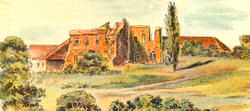History of Moravian Brethern in Russian Poland
The following history is provided by SGGEE member Cy Harke and is reprinted with permission. Contact the webmaster for information on how to obtain a more detailed historical pamphlet (39 pages).
Jump to local histories, pictures and more
General History of the Moravian Brethren
The Moravian Church is often referred to in history as the "Standard Bearer of Protestantism" as it was the first to break away from the Church of Rome.
Slavic people in Bohemia and Moravia, later becoming provinces of Czechoslovakia, obtained their Christian teachers from Constantinople which was the headquarters of the Greek Church. This was first encouraged by the Church of Rome but later met with disfavor as services were not conducted in Latin. Eventually, all Greek priests were banished and the Slavic churches were forced to conform to the practices of Rome.
A brilliant scholar by the name of John Hus, born in 1369, studied under Greek Church teachers in a Bohemian monastery and at the University of Prague. Later, he was appointed preacher at Bethlehem Chapel in Prague. His teachings and writings condemned the practices of Rome as not being in accordance with biblical teachings. This resulted in excommunication by the Pope and a summons to appear before the Church Council in Constance, Germany in 1414. He was arrested later, imprisoned, and in 1415 was burned at the stake.
The teachings of Hus had such an impact on the people of Bohemia that they founded a church of their own in 1457, giving it a Latin name, Unitas Fratrum, or Unity of Brethern. Many large and impressive churches, schools and publishing houses were established throughout Bohemia, Moravia and Poland. Through years of bitter persecution during the Thirty Years War and the Counter-Reformation period, the Unitas Fratrum was destroyed. In 1722, small groups from Moravia and Bohemia fled their homeland into the neighbouring Kingdom of Saxony and established a village which they named Herrnhut. The Unitas Fratrum was thus revived and incorporated as the Moravian Church since many came from Moravia.
A unique characteristic of the early Moravian Church was the "Diaspora" or visitation ministry to Moravians who lived dispersed in small groups in areas where no Moravian congregations existed. A vital element of the visitation program was the distribution of a daily devotional booklet, "The Text Book". This has been in continuous publication since 1731 and now appears in over twenty languages.
Administration and Establishment of the Moravian Churches
The administrative centre of the Church in earlier times was designated as "Unitats-Aeltesten-Konferenz"(U.A.C.), located at Berthelsdorf, near Herrnhut. The designation was changed to "Deutsche Unitats-Direktion"(D.U.D.) in 1889 and the centre was moved to Herrnhut in 1913.
Pastors reported directly to the U.A.C. in earlier times. Later, Directors were appointed and they took charge of conferences for lay-workers, acqainted new Pastors with the work and had to answer to Herrnhut for the over-all work of Pastors and lay-workers.
Directors for the years indicated were as follows:
1907 - 1917 Pastor Paul Wunderling, Lodz Pastor
1921 - 1923 Pastor Hermann Hochstein, Reichenau Pastor
1923 - 1928 Pastor P.P. Schmidt, Pabianice Pastor
1935 - 1945 Pastor E. Schiewe, Reichenau Pastor
There was very little or no financial support given to ministers destined for Poland. A large part of the collections taken at Saturday and Sunday services went to Berthelsdorf for Missions, the balance for operation of the prayer-hall or church, and the minister's salary. There were some problems with the Lutherans but these generally got resolved. Church services were scheduled so that there were no conflicts. Moravian services were well attended due to the popularity of music by choirs and brass bands, various festivals, special events, etc. Births, deaths and marriages were handled by the Catholics or Lutherans.
Establishing new Moravian congregations was slow due the lack of financial support and the availability of ministers. Ministers were often restricted to congregational visits only once or twice a year. Lay-workers played a major role in conducting services and maintaining the continuity of assemblies and congregations. Authorities in Warsaw generally insisted that Moravian ministers be Polish citizens.
The beginning of Moravian assemblies took place in the Neusulzfeld(Nowosoln) colony and in the village of Lwowek(Leonberg). Other assemblies and congregations in the surrounding regions were established from these centres and both became District Headquarters.
Work ended or had to be abandoned when all Germans had to flee in Jan 1945.
Before the outbreak of WW II in 1939, all 8 Pastor's posts were filled. Two required assistants. At this time, statistics showed 1800 members, 4000 affiliates, 10,000 visitors.
On August 13, 1946, a number of displaced members from Moravian congregations in Poland, were able to establish the Neugnadenfeld Congregation at Emsland, Germany.
Map of Moravian Congregations in Poland, 1900-1945.
| Neusulzfeld History | Photos | More |
Leonberg History | Photos | More |
| Reichenau History | Photos | More |
Radom History | Photos | More |


